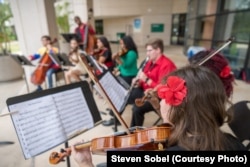Choosing a college or university in the United States is not an exact science. It can be hard to know if you have made the right decision, no matter what school you attend.
You might think you like the qualities of a school that accepts you, especially if it is high on your list of schools you want to attend.
But once you have gone through the process of application and admission, you may start to feel differently about your school choice.
Once you arrive, you may find that you wish your classes were smaller, or that you were in a more active city. You might dislike the school’s rules or atmosphere, or maybe it costs more than you expected.
In time, you could come to regret your choice of college or university.
But Linda Herlocker says there is nothing wrong with having doubts; what matters is how you deal with them. Herlocker is the assistant vice president for admissions and records at Valencia College. The Orlando, Florida community college offers mainly two-year associate’s degree programs, but also a few bachelor’s degree programs.
Herlocker says if a student decides they can no longer continue their studies where they started, it does not have to mean the end of their higher education. In fact, many college and university students begin their studies knowing that they will not complete their programs where they started.
That is especially true of community colleges like Valencia, Herlocker notes. However, she says it is important that students think hard about changing schools, no matter their reason for wanting to.
For some people, higher education is not always the best path to take, especially within a few months of graduating from high school, when most Americans start college. Herlocker says students might want to consider that possibility, even after they have transferred.
“Is it a problem that can be solved by transfer? Sometimes it is,” she told VOA. “But I just want to make sure that students make those decisions within the right context and with a good understanding of why they’re making that decision.”
Once a student has decided it is time to change schools, there are several steps they must take as soon as possible, notes Herlocker.
First, of course, the must identify the college or university they wish to attend. Some schools, especially community colleges like Valencia, have partnerships with other institutions that make the process simpler. It can also be easier to transfer from one public institution to another than to move from a private to a public school, or the other way around, Herlocker adds.
But, she suggests no matter what new school a student chooses, it is extremely important that the student contact it right away.
Most colleges and universities in the U.S. begin their official academic year in the fall. Many schools divide their academic year into two study periods called semesters. Almost all public institutions permit students to enter study in the second semester. But some private schools let students start only in the fall.
Also, some public and private institutions have group programs that require students to work together from the beginning. And students may not transfer in during the middle of those programs.
A student can seek answers to any transfer questions from admissions officials at the school of interest. Such questions might concern application materials and dates of submission and admission.
Many schools begin accepting application materials two semesters, or a full year, before they offer admission to or reject candidates. But Herlocker warns that applicants will never know details like that for sure unless they communicate with a school. And transfer students should stay in contact with their new school throughout the entire process, to make sure there that no steps are being missed.
There is one quality that can make transfer students a little more desirable than first-time applicants, Herlocker says. They already have an academic record at a college or university. If they did well, it shows they can succeed in higher education.
She suggests the study programs at community colleges like Valencia, can be less intense than those at four-year schools. Some students start at schools like Valencia in order to ease into the college learning environment.
The main requirement for transfer students is a record of their academic performance at the college or university they are leaving.
The situation is a little different for international students. If they are transferring from a school in their home country, that school’s study programs must be approved by an accrediting agency. But still, Herlocker says, these records should show exactly how well a student can perform at the college or university-level.
“The student has already proven themselves,” she said. “So, no one’s in the business of looking for reasons to exclude, if you will. If they already have a … positive … record, in my experience, any institution would be happy to have them.”
Once a student has been accepted into their desired transfer school, there is still one more thing they need to do, notes Herlocker. They should attend their new school’s orientation.
Orientations are special informational programs that colleges and universities offer whenever they admit a new group of students. These programs usually take place a week or so before the start of a new school year or semester, and often last several days.
Herlocker says orientation is important for both new and experienced students.
“Every institution is different,” she said. “And it’s really, really important to attend the orientation for the institution that you’re transferring to, because that’s where you find out what the rules are, how things work, and most importantly, what are all those support services that … can … help you be successful in your program.”
I’m Pete Musto. And I’m Dorothy Gundy.
Pete Musto reported this story for VOA Learning English. Caty Weaver was the editor. We want to hear from you. How common is transferring from one college or university to another in your country? How simple or complex is the process? Write to us in the Comments Section or on our Facebook page.
_____________________________________________________________
Quiz
_____________________________________________________________
Words in This Story
application – n. a formal and usually written request for something, such as a job, admission to a school, or a loan
doubt(s) – n. a feeling of being uncertain or unsure about something
associate’s degree – n. a degree that is given to a student who has completed two years of study at a junior college, college, or university in the U.S.
bachelor’s degree – n. a degree that is given to a student by a college or university usually after four years of study
graduating – v. earning a degree or diploma from a school, college, or university
transfer(red) – v. to stop going to one school and begin going to another
context – n. the group of conditions that exist where and when something happens
institution(s) – n. an established organization
academic – adj. of or relating to schools and education
submission – n. an act of giving an application, document, proposal, or piece of writing to someone so that it can be considered or approved
accrediting – v. saying that something is good enough to be given official approval
positive – adj. good or useful














